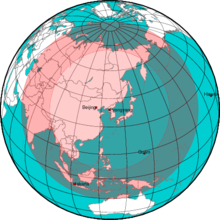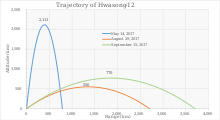Hwasong-12: Difference between revisions
m →List of Hwasong-12 tests: N. Korea uses UTC+8:30, not UTC+9 used by S. Korea |
|||
| Line 75: | Line 75: | ||
|- |
|- |
||
! scope="row" | 5 |
! scope="row" | 5 |
||
| 29 August 2017 05: |
| 29 August 2017 05:28 a.m. [[Pyongyang Standard Time]]<ref>{{cite web|title=Nordkoreas Diktator hat sich für eine erneute Provokation entschieden. Die USA reagieren scharf: "Alle Optionen sind auf dem Tisch". (in German)|url=https://www.abendblatt.de/politik/article211751321/Kims-Jong-uns-Raketentest-loest-in-Japan-Kriegsangst-aus.html|website=Abendblatt|accessdate=29 August 2017}}</ref><ref>{{cite web |title=Trump and Abe vow to increase pressure after North Korea fires missile over Japan |date=29 August 2017 |work=The Gurdian |url=https://www.theguardian.com/world/2017/aug/28/north-korea-fires-missile-japan}}</ref> || [[Pyongyang International Airport|Sunan]] || None |
||
|| '''Success''' || Missile was fired on a normal trajectory with apogee of 550 km, flew over [[Hokkaido]] in total distance of 2700 km, landed in the Pacific Ocean 1180 km east of the northern Japanese island. |
|| '''Success''' || Missile was fired on a normal trajectory with apogee of 550 km, flew over [[Hokkaido]] in total distance of 2700 km, landed in the Pacific Ocean 1180 km east of the northern Japanese island. |
||
|- |
|- |
||
Revision as of 05:28, 1 September 2017
| Hwasong-12 | |
|---|---|
| Type | Ballistic missile, Mobile IRBM/ICBM |
| Place of origin | North Korea |
| Service history | |
| In service | Successful test on 14 May 2017[1] |
| Used by | North Korea |
| Production history | |
| Manufacturer | North Korea |
| Specifications | |
| Mass | 28 tons (est.) |
| Height | 16 m (est.) |
| Warhead |
|
| Warhead weight | 500-650 kg (est.) |
| Engine | Liquid-propellant rocket (same or derived from R-27 or R-29 or indigenous/domestic design such as "March 18 Revolution"[2][3][3]) |
| Propellant | Hypergolic combination of unsymmetrical dimethylhydrazine (UDMH) as fuel, and either Dinitrogen tetroxide (N 2O 4) or red fuming nitric acid (RFNA) as oxidizer |
Operational range | 3,700–6,000 km (est.)[4][5] |
| Flight altitude | 2,111.5 km at lofted trajectory (which reduces range to 787 km) |
Guidance system | Inertial |
Launch platform | MAZ-based vehicle |
| Korean name | |
| Chosŏn'gŭl | 화성 12 |
|---|---|
| Hancha | |
| Revised Romanization | Hwasong-12 |
| McCune–Reischauer | Hwasong-12 |
Template:Contains Korean text The Hwasong-12 (Chosŏn'gŭl: 화성 12; Hanja: 火星 12, meaning Mars 12), which has an alternative name, KN-17,[6] in intelligence communities outside North Korea, is a mobile intermediate-range ballistic missile developed by North Korea. The Hwasong-12 was first revealed to the international community in a military parade on 14 April 2017 celebrating the Day of the Sun which is the birthday anniversary of North Korea's founding President, Kim Il-Sung.
Design

Based on photos of the launch on 14 May 2017, the Hwasong-12 appears to be a single stage design, using a single main engine along with four vernier engines. The arrangement appears similar to the "high-thrust" engine test conducted in March 2017.[7] Alternatively, it could be based on the engine used in the older Hwasong-10 with the addition of two more verniers.[4]
Initial estimates suggest the Hwasong-12 would have a maximum range of between 3,700 kilometres (2,300 mi)[4] and 6000 km (ICBM means a range of at least 5500 km).[5] In the April 2017 military parade the Hwasong-12 was displayed on the Hwasong-10 mobile launcher, and it may be intended to replace the similarly performing Hwasong-10 which has been shown unreliable during its test program.[8][9]
List of Hwasong-12 tests

| Attempt | Date | Location | Pre-launch announcement / detection | Outcome | Additional Notes |
|---|---|---|---|---|---|
| 1 | 4 April 2017 06:12 a.m. Pyongyang Standard Time[10] | Sinpo | None | Failed | Previously misreported as a SCUD variant.[11] Missile traveled a range of 60 kilometers with an apogee of 189 kilometers and reportedly "pinwheeled" before flight was terminated.[12] |
| 2 | 15 April 2017 05:51 a.m. Pyongyang Standard Time[13] | Sinpo | None | Failed | Previously misreported as a SCUD variant.[11] Reported to have exploded within 4, 5 seconds after launch.[14] |
| 3 | 28 April 2017 05:33 a.m. Pyongyang Standard Time[15] | Pukchang | None | Failed | Missile reportedly flew 25 miles before exploding.[16] |
| 4 | 14 May 2017 04:58 a.m. Pyongyang Standard Time[17] | Kusong | None | Success | Missile was fired on a lofted trajectory with apogee of 2,111.5 km, landing 787 km away in the Sea of Japan. |
| 5 | 29 August 2017 05:28 a.m. Pyongyang Standard Time[18][19] | Sunan | None | Success | Missile was fired on a normal trajectory with apogee of 550 km, flew over Hokkaido in total distance of 2700 km, landed in the Pacific Ocean 1180 km east of the northern Japanese island. |
Technical specifications
Template:North Korean missile range.svg
Current operators
See also
References
- ^ (Kim Jong Un Guides Test-fire of Ballistic Rocket Hwasong-12) - Youtube, courtesy of KCNA/ChosunTV
- ^ Diplomat, Ankit Panda and Vipin Narang, The. "North Korea's ICBM: A New Missile and a New Era". Retrieved 18 August 2017.
{{cite web}}: CS1 maint: multiple names: authors list (link) - ^ a b "North Korea's Hwasong-12 Missile: Stepping Stone to an ICBM - NTI". www.nti.org. Retrieved 18 August 2017.
- ^ a b c Savelsberg, Ralph (19 May 2017). "A Quick Technical Analysis of the Hwasong-12". 38 North. U.S.-Korea Institute, Johns Hopkins University School of Advanced International Studies. Retrieved 24 May 2017.
- ^ a b 김효정 (15 May 2017). "北 "신형 중장거리미사일 발사 성공"…김정은 "美본토 타격권"(종합)". Retrieved 18 August 2017.
- ^ "Hwasong-12 - Missile Threat". Retrieved 18 August 2017.
- ^ "Kim Jong Un Watches Ground Jet Test of Newly Developed High-Thrust Engine". NK Watch. KCNA. Retrieved 21 May 2017.
- ^ Schilling, John (14 May 2017). "North Korea's Latest Missile Test: Advancing towards an Intercontinental Ballistic Missile (ICBM) While Avoiding US Military Action". 38 North. U.S.-Korea Institute, Johns Hopkins University School of Advanced International Studies. Retrieved 15 May 2017.
- ^ Panda, Ankit (15 May 2017). "North Korea's New Intermediate-Range Ballistic Missile, the Hwasong-12: First Takeaways". The Diplomat. Retrieved 15 May 2017.
- ^ "U.S. Pacific Command detects, tracks North Korean missile launch". US Forces Korea. Retrieved 3 June 2017.
- ^ a b Tomlinson, Lucas. "NoKo failed missile is KN-17, new type of Scud, US officials tell Fox". Fox News. Fox. Retrieved 3 June 2017.
- ^ Wright, David. "North Korea's April 5 Missile Launch". All Things Nuclear. Union of Concerned Scientists. Retrieved 3 June 2017.
- ^ "U.S. Pacific Command detects North Korean missile launch". US Forces Korea. Retrieved 3 June 2017.
- ^ Schabnder, Dean. "North Korea's attempted missile launch fails, US officials say". ABC. Retrieved 3 June 2017.
- ^ "U.S. Pacific Command detects North Korean missile launch". US Forces Korea. Retrieved 3 June 2017.
- ^ Tomlinson, Lucas (28 April 2017). "North Korea test-fires a ballistic missile that breaks up in flight, US officials say". Fox News. Fox. Retrieved 3 June 2017.
- ^ "U.S. Pacific Command detects, tracks North Korean missile launch". US Forces Korea. Retrieved 3 June 2017.
- ^ "Nordkoreas Diktator hat sich für eine erneute Provokation entschieden. Die USA reagieren scharf: "Alle Optionen sind auf dem Tisch". (in German)". Abendblatt. Retrieved 29 August 2017.
- ^ "Trump and Abe vow to increase pressure after North Korea fires missile over Japan". The Gurdian. 29 August 2017.
